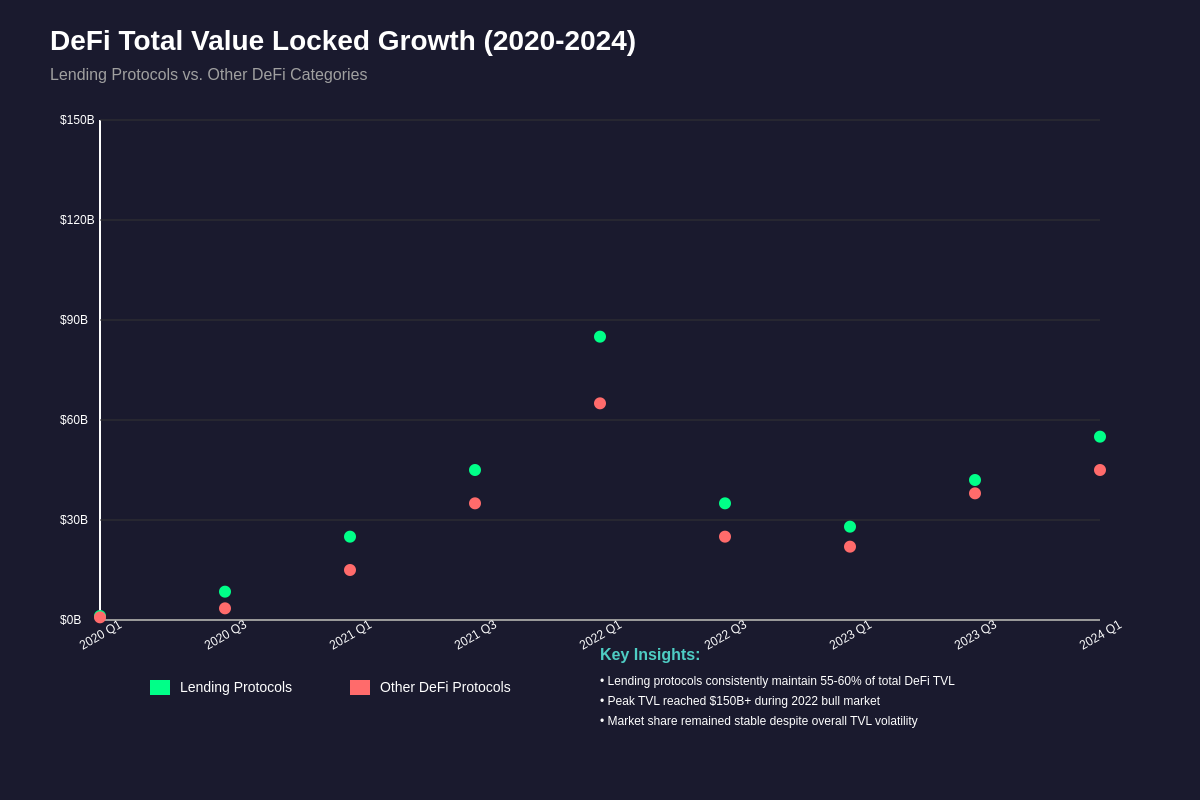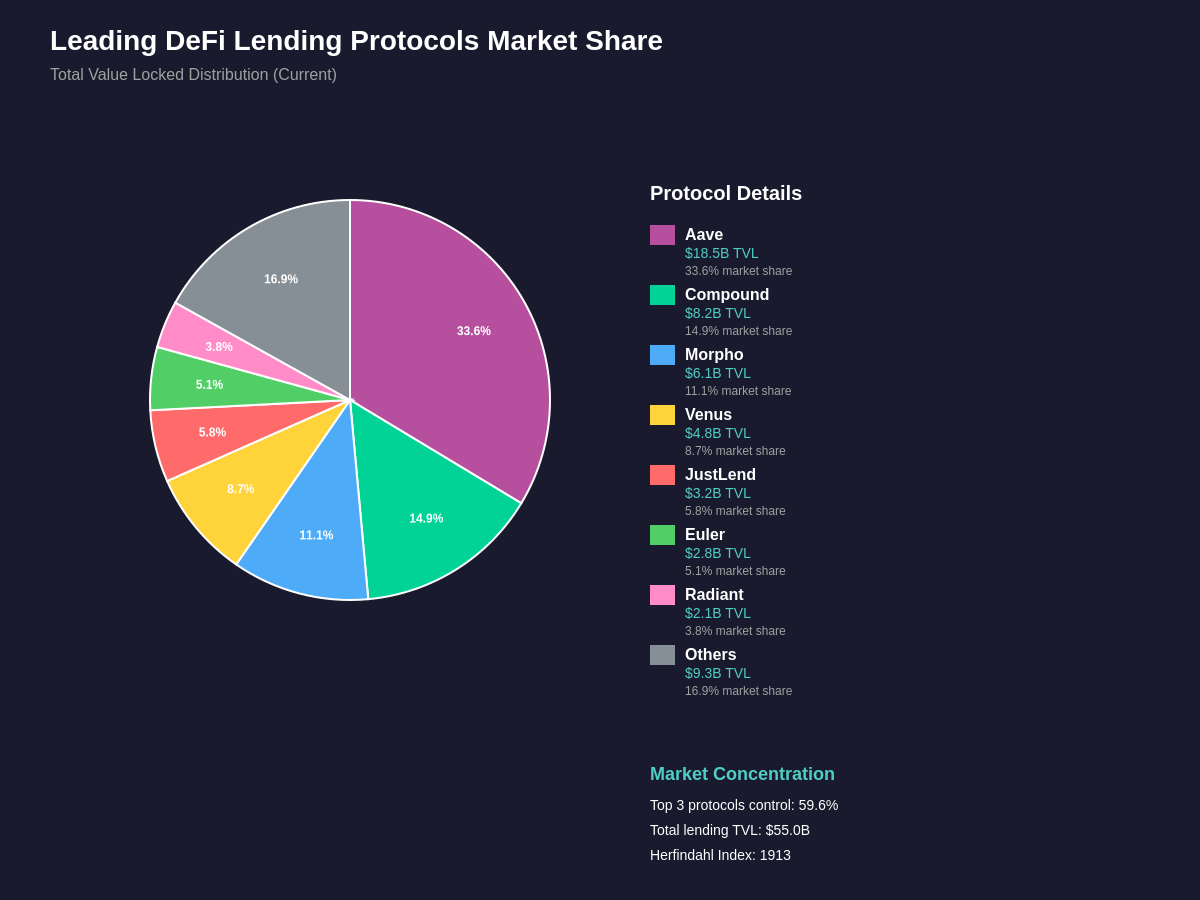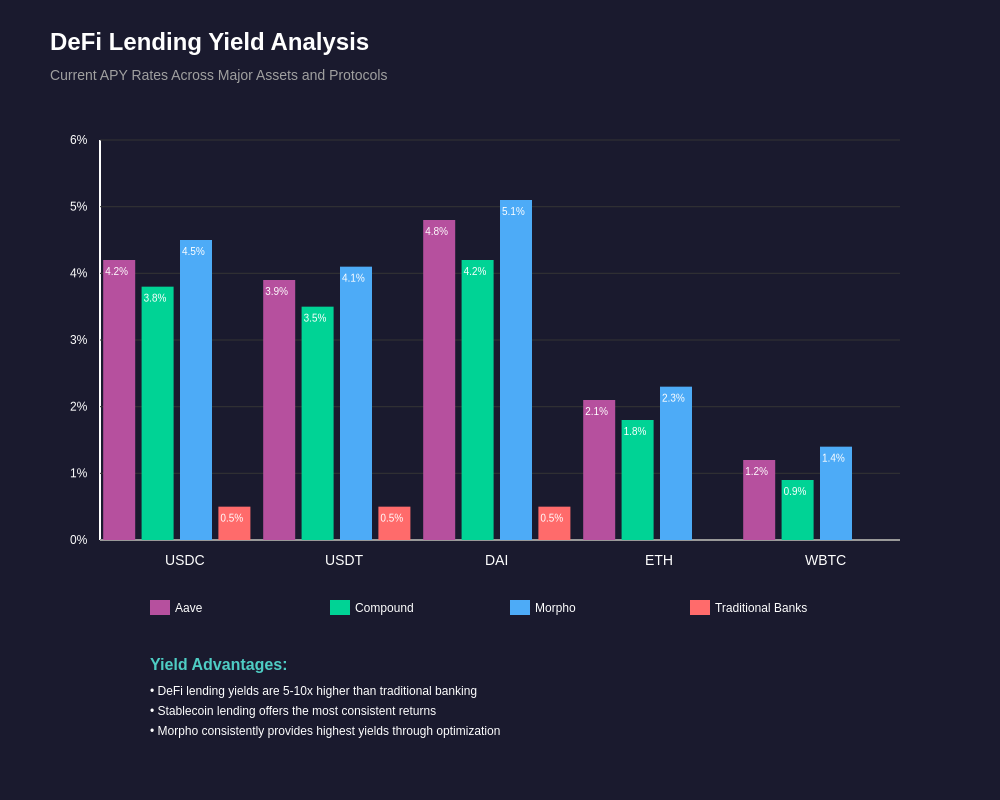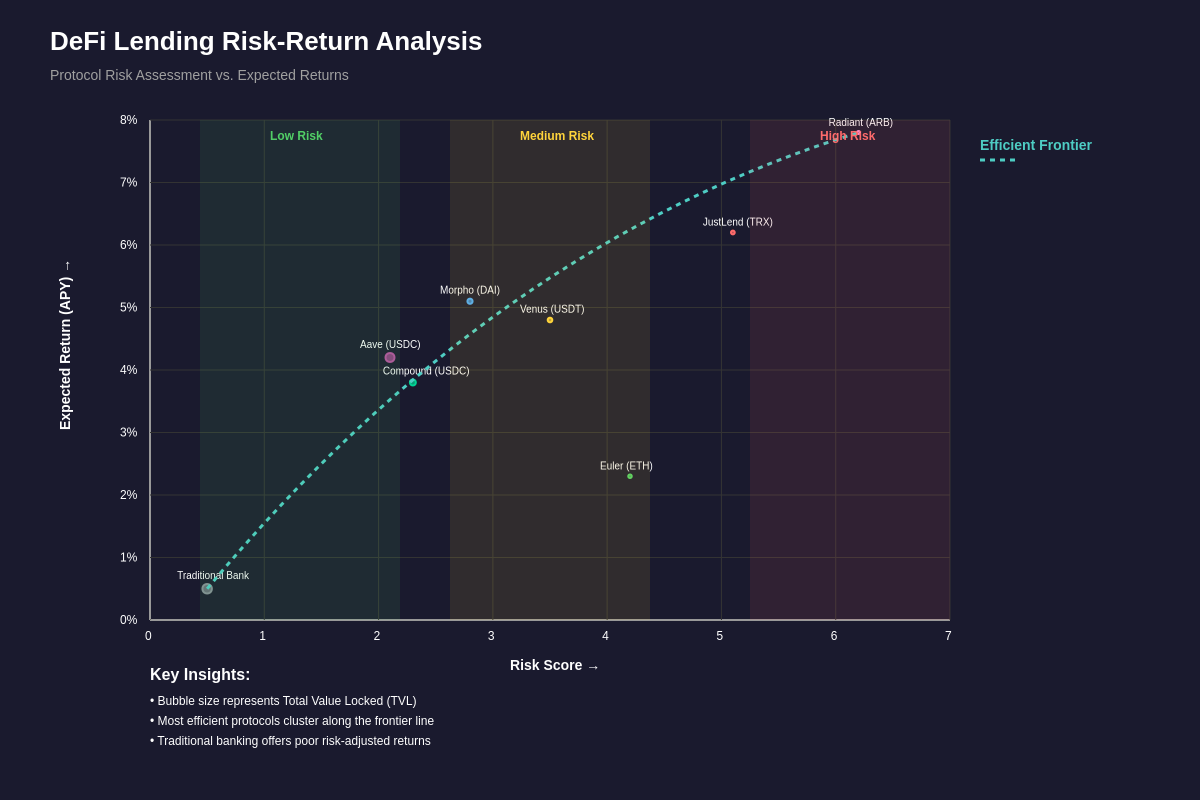The Evolution of DeFi’s Financial Infrastructure
The decentralized finance ecosystem has experienced unprecedented growth in Total Value Locked (TVL), with lending protocols emerging as the dominant force driving capital allocation and yield generation across blockchain networks. This remarkable expansion reflects the maturation of DeFi infrastructure and the increasing sophistication of yield farming strategies, as institutional and retail investors alike seek alternative sources of returns in an environment characterized by traditional financial market volatility and historically low interest rates offered by conventional banking systems.
Lending protocols have fundamentally transformed how cryptocurrency holders approach asset management and capital efficiency, enabling users to earn passive income on their holdings while maintaining exposure to underlying asset appreciation. The mechanics of these protocols create compelling yield opportunities that can be tracked and analyzed through comprehensive charting platforms, allowing sophisticated investors to optimize their strategies based on real-time market data and historical performance metrics.
The dominance of lending protocols within the broader DeFi landscape represents more than just a shift in how users interact with their cryptocurrency holdings; it signifies the emergence of a parallel financial system that operates independently of traditional banking infrastructure while offering competitive and often superior returns to depositors. This transformation has occurred alongside rapid innovation in protocol design, risk management mechanisms, and user experience improvements that have made DeFi lending accessible to a broader audience of cryptocurrency users.

Historical Context and Market Development
The evolution of DeFi lending protocols can be traced back to the early experimental phases of decentralized finance, when pioneering platforms like MakerDAO introduced the concept of collateralized debt positions and algorithmic stablecoin creation. These early innovations laid the groundwork for more sophisticated lending mechanisms that would eventually capture hundreds of billions of dollars in total value locked across multiple blockchain networks.
The progression from simple peer-to-peer lending contracts to automated market-making protocols and algorithmic interest rate determination represents a fundamental shift in how financial services can be delivered through smart contract automation. Early adopters who recognized the potential of these systems were able to participate in yield farming opportunities that generated returns significantly exceeding those available through traditional financial instruments, though often with correspondingly higher risks and complexity requirements.
Market development accelerated dramatically during the 2020 DeFi summer, when liquidity mining incentives and governance token distributions created powerful economic incentives for capital deployment into lending protocols. This period established many of the dominant platforms that continue to lead the market today, while also demonstrating both the potential rewards and risks associated with decentralized lending mechanisms. Historical yield data and protocol performance metrics from this era provide valuable insights into the cyclical nature of DeFi yields and the factors that drive capital flows between different protocols and strategies.
The maturation of lending protocols has been accompanied by increasing institutional adoption, as traditional financial institutions and cryptocurrency-focused investment funds have begun allocating significant capital to DeFi lending strategies. This institutional participation has brought additional liquidity and stability to the market while also driving demand for more sophisticated risk management tools and compliance mechanisms that align with institutional investment requirements.
Dominant Lending Protocol Architectures
The architecture of successful lending protocols reflects careful balance between capital efficiency, risk management, and user experience optimization, with different platforms adopting varying approaches to interest rate determination, collateral requirements, and liquidation mechanisms. Pool-based lending models have emerged as the dominant paradigm, enabling users to deposit assets into shared liquidity pools that automatically match borrowers and lenders while optimizing interest rates based on supply and demand dynamics.
Compound and Aave represent the archetypal implementations of pool-based lending, with their smart contract systems automatically adjusting interest rates based on utilization ratios and enabling seamless borrowing and lending experiences for users across a wide range of supported assets. These protocols have demonstrated remarkable resilience and growth, maintaining their positions as market leaders while continuously innovating to address emerging challenges and opportunities in the DeFi ecosystem.

The innovation in lending protocol design extends beyond basic borrowing and lending functionality to include advanced features such as flash loans, which enable sophisticated arbitrage strategies and capital efficiency improvements for experienced users. These mechanisms have created entirely new categories of financial strategies while also introducing novel risks that require careful consideration by protocol developers and users alike.
Yield optimization strategies have become increasingly sophisticated, with many users employing automated systems to continuously reallocate capital between different lending protocols based on changing yield rates and risk assessments. This dynamic capital allocation creates competitive pressure among protocols to maintain attractive yields while managing risk effectively, driving continuous innovation in protocol design and incentive mechanisms.
Total Value Locked Metrics and Analysis
The measurement and analysis of Total Value Locked across DeFi lending protocols provides crucial insights into capital flows, user preferences, and the relative health of different platforms within the broader decentralized finance ecosystem. TVL metrics serve as a primary indicator of protocol adoption and success, though they must be interpreted carefully to account for factors such as token price appreciation, liquidity mining incentives, and seasonal variations in user behavior.
Current TVL distribution across major lending protocols reveals the concentration of capital among a relatively small number of dominant platforms, with Aave, Compound, and newer entrants like Morpho capturing the majority of lending market share. This concentration reflects both the network effects associated with liquidity and the trust that users place in battle-tested protocols with strong security track records and proven operational stability.
The relationship between TVL and actual protocol revenue generation provides important context for understanding the sustainability of different lending platforms and their long-term viability in an increasingly competitive market. Protocols that can demonstrate consistent fee generation relative to their TVL are generally better positioned to weather market downturns and continue investing in development and security improvements over time.
Comprehensive TVL tracking and analysis tools enable investors and researchers to monitor capital flows across different protocols and identify trends that may indicate shifting user preferences or emerging opportunities within the lending sector. These tools have become essential for sophisticated DeFi participants who need to make informed decisions about capital allocation and risk management in a rapidly evolving market environment.
Interest Rate Mechanisms and Yield Generation
The mechanics of interest rate determination within DeFi lending protocols represent a significant innovation in financial engineering, utilizing algorithmic systems to automatically adjust borrowing and lending rates based on real-time supply and demand dynamics. These systems eliminate the need for traditional financial intermediaries while providing more responsive and efficient interest rate discovery mechanisms than those typically found in conventional banking systems.
Variable interest rate models employed by most major lending protocols create dynamic yield opportunities that can change rapidly based on market conditions and protocol utilization rates. Users who understand these mechanics can optimize their lending strategies by monitoring utilization rates and predicting when rates are likely to increase or decrease based on broader market conditions and seasonal patterns in DeFi activity.
The implementation of stable rate borrowing options alongside variable rates provides additional flexibility for users who prefer predictable borrowing costs, though these features are less commonly utilized than variable rate mechanisms due to their generally higher costs and reduced flexibility. The interplay between stable and variable rate borrowing creates complex dynamics that sophisticated users can exploit to optimize their overall borrowing and lending strategies.
Compound interest accrual mechanisms within lending protocols create powerful wealth-building opportunities for long-term depositors, as earned interest is automatically reinvested to generate additional returns over time. This compounding effect can significantly enhance overall returns for patient investors who maintain positions through various market cycles, though it also requires careful attention to potential risks such as smart contract vulnerabilities and market volatility that could impact underlying asset values.

Risk Assessment and Management Frameworks
The risk landscape associated with DeFi lending protocols encompasses multiple categories of potential threats, including smart contract vulnerabilities, market volatility risks, liquidity constraints, and governance-related concerns that can impact both individual users and the broader protocol ecosystem. Effective risk management requires comprehensive understanding of these various threat vectors and their potential interactions during periods of market stress or protocol evolution.
Smart contract risk represents perhaps the most fundamental concern for DeFi lending participants, as vulnerabilities in protocol code can result in complete loss of deposited funds with little recourse for affected users. The security audit process for major lending protocols has become increasingly rigorous, with multiple independent security firms conducting comprehensive reviews and ongoing monitoring to identify potential vulnerabilities before they can be exploited by malicious actors.
Liquidation mechanisms designed to protect lending protocols from bad debt creation can sometimes result in unexpected losses for borrowers during periods of extreme market volatility, when price movements occur faster than users can respond to margin calls or add additional collateral to their positions. Understanding liquidation thresholds and maintaining appropriate collateral buffers is essential for borrowers who wish to avoid forced liquidations that can result in significant financial losses.
Governance risks associated with protocol upgrades and parameter changes represent an often-overlooked threat vector that can significantly impact user returns and capital safety over time. Active monitoring of governance proposals and voting patterns can help users anticipate changes that might affect their positions, while diversification across multiple protocols can reduce exposure to governance-related risks that might impact any single platform.
Institutional Adoption and Market Maturation
The increasing participation of institutional investors in DeFi lending markets has brought significant changes to the competitive landscape, user experience requirements, and regulatory considerations that shape protocol development and adoption patterns. Institutional demand for sophisticated risk management tools, compliance capabilities, and enhanced customer support has driven innovation in protocol design and ancillary service development throughout the DeFi ecosystem.
Regulatory clarity regarding DeFi lending activities remains limited in most jurisdictions, creating uncertainty for institutional participants who must navigate complex compliance requirements while participating in protocols that may not align perfectly with traditional financial regulatory frameworks. This regulatory uncertainty has led to the development of specialized institutional platforms and service providers that attempt to bridge the gap between DeFi innovation and institutional compliance requirements.
The impact of institutional capital flows on DeFi lending yields has been generally positive for retail users, as increased liquidity and competition among borrowers has helped maintain attractive lending rates even as the broader cryptocurrency market has experienced significant volatility. However, institutional participation has also introduced new dynamics and dependencies that may affect protocol stability and user experience during periods of institutional capital flight or risk-off market conditions.
Professional asset management firms specializing in DeFi strategies have emerged to serve institutional clients who lack the internal expertise or risk tolerance to directly manage DeFi lending positions. These firms provide valuable liquidity and stability to the market while also creating additional layers of complexity and potential systemic risk that must be carefully monitored by both regulators and protocol developers.
Cross-Chain Lending and Multi-Protocol Strategies
The expansion of DeFi lending beyond Ethereum to include multiple blockchain networks has created new opportunities for yield optimization and risk diversification, while also introducing additional complexity in terms of cross-chain asset management and protocol interaction. Multi-chain lending strategies enable sophisticated users to arbitrage yield differentials between different networks while accessing unique opportunities that may be available only on specific blockchain platforms.
Cross-chain bridges and interoperability protocols have enabled the development of sophisticated multi-protocol lending strategies that can automatically rebalance capital across different networks and protocols based on changing yield opportunities and risk assessments. These strategies require careful attention to bridge security risks and cross-chain transaction costs that can significantly impact overall returns if not properly managed.
The emergence of native multi-chain lending protocols represents an evolution beyond simple cross-chain asset bridging, enabling users to access unified lending experiences that span multiple blockchain networks while maintaining simplified user interfaces and risk management frameworks. These protocols face unique technical and security challenges related to cross-chain state synchronization and asset custody that require innovative solutions and extensive security testing.
Advanced charting and analysis tools for cross-chain yield comparison and optimization have become essential for users seeking to maximize returns across multiple networks and protocols. These tools help users identify arbitrage opportunities and optimize their asset allocation strategies while accounting for the additional risks and costs associated with cross-chain operations.
Emerging Technologies and Protocol Innovation
The continued evolution of DeFi lending protocols reflects ongoing innovation in areas such as automated yield optimization, advanced risk assessment mechanisms, and novel collateral types that expand the range of assets that can be effectively utilized within lending frameworks. These innovations are driving the next phase of growth in DeFi lending while also creating new opportunities and challenges for both users and protocol developers.
Automated vault strategies and yield optimization protocols have emerged as popular solutions for users who prefer to delegate the complexity of active yield farming to specialized smart contract systems. These protocols can automatically rebalance capital across multiple lending platforms and strategies while managing risks and optimizing returns based on sophisticated algorithms and market analysis capabilities.
The integration of real-world assets and tokenized securities into DeFi lending protocols represents a significant expansion of the addressable market for decentralized lending, though it also introduces new regulatory and operational challenges that require careful navigation. These developments could potentially bridge traditional finance and DeFi in ways that dramatically expand the total addressable market for decentralized lending services.
Machine learning and artificial intelligence applications in DeFi lending are beginning to emerge, with some protocols experimenting with AI-powered risk assessment mechanisms and automated parameter optimization systems that can respond more quickly and effectively to changing market conditions than traditional rule-based systems.
Economic Impact and Market Dynamics
The economic impact of DeFi lending protocol dominance extends beyond the immediate benefits to protocol users to include broader effects on cryptocurrency market dynamics, capital allocation efficiency, and the development of supporting infrastructure and services throughout the blockchain ecosystem. The growth of lending protocols has created new sources of demand for various cryptocurrency assets while also enabling more sophisticated capital markets development.
The relationship between DeFi lending yields and broader cryptocurrency market conditions creates complex feedback loops that can amplify both positive and negative market movements depending on the specific circumstances and user behavior patterns. Understanding these dynamics is crucial for both individual investors and institutional participants who need to anticipate how lending market conditions might evolve in response to broader market changes.
Competition among lending protocols has driven continuous innovation and improvement in user experience, security practices, and yield generation mechanisms, creating a virtuous cycle that benefits the entire DeFi ecosystem. This competitive dynamic has also led to the emergence of specialized protocols that focus on specific niches or user segments, contributing to the overall diversity and resilience of the DeFi lending landscape.
The macroeconomic implications of DeFi lending growth include potential impacts on traditional banking systems, monetary policy transmission mechanisms, and global capital allocation patterns that could become increasingly significant as the scale of DeFi lending continues to expand over time.
Regulatory Landscape and Compliance Considerations
The regulatory treatment of DeFi lending protocols varies significantly across different jurisdictions, with some regions taking progressive approaches that encourage innovation while others have implemented restrictive measures that limit access to decentralized lending services. This regulatory fragmentation creates challenges for both protocol developers and users who must navigate complex and evolving compliance requirements.
The classification of DeFi lending activities under existing financial regulations remains unclear in many jurisdictions, creating uncertainty about licensing requirements, consumer protection obligations, and reporting responsibilities that may apply to different types of protocol participants. This uncertainty has led some protocols to implement geographical restrictions or compliance measures that may limit their accessibility or functionality in certain regions.
The development of regulatory frameworks specifically designed for DeFi lending represents an ongoing process that requires collaboration between regulators, industry participants, and technology experts to create balanced approaches that protect consumers while preserving the innovation and efficiency benefits that characterize decentralized lending systems.
Compliance technology solutions for DeFi lending are evolving to help protocols and users meet regulatory requirements while maintaining the benefits of decentralized operation, though these solutions often involve trade-offs between privacy, decentralization, and regulatory compliance that must be carefully evaluated by all stakeholders.
Future Projections and Market Evolution
The future evolution of DeFi lending protocol dominance will likely be shaped by continued innovation in areas such as automated risk management, cross-chain interoperability, and integration with traditional financial systems, while also being influenced by regulatory developments and broader cryptocurrency market adoption trends. These factors will determine whether current growth trajectories can be sustained and how the competitive landscape among different protocols might evolve over time.
Potential disruptions to current lending protocol dominance could come from entirely new approaches to decentralized lending, changes in underlying blockchain infrastructure that alter the economics of protocol operation, or regulatory developments that significantly impact the ability of current protocols to serve their existing user bases effectively.
The integration of decentralized lending with other DeFi primitives such as derivatives, insurance, and asset management protocols is likely to create increasingly sophisticated financial products and services that could expand the total addressable market for DeFi lending while also creating new risks and opportunities for market participants.
Long-term sustainability of current yield levels in DeFi lending will depend on continued growth in borrowing demand and the development of sustainable revenue models that can support attractive lending rates without relying excessively on token incentives or unsustainable economic mechanisms.
Strategic Implications for Investors
The dominance of lending protocols within the DeFi ecosystem creates both opportunities and challenges for different types of investors, from retail cryptocurrency enthusiasts to sophisticated institutional capital allocators. Understanding the strategic implications of this dominance is crucial for making informed investment decisions and developing effective portfolio management strategies in the evolving DeFi landscape.
Risk-adjusted return analysis of DeFi lending strategies requires careful consideration of multiple factors including protocol security, yield sustainability, liquidity risks, and regulatory uncertainties that may not be immediately apparent to less experienced investors. Comprehensive analytical tools and historical performance data can help investors make more informed decisions about their DeFi lending allocations and risk management strategies.
Portfolio diversification strategies for DeFi lending exposure should account for correlations between different protocols, underlying asset exposures, and broader cryptocurrency market dynamics that can impact the effectiveness of diversification efforts during periods of market stress or systemic risk events that affect the entire DeFi ecosystem.
The timing of DeFi lending investments can significantly impact overall returns, as yield rates and risk levels fluctuate based on market conditions, protocol developments, and broader cryptocurrency adoption trends that create cyclical patterns in lending market attractiveness and accessibility.

This article is for informational purposes only and does not constitute financial advice. Cryptocurrency investments involve significant risks, including the potential for total loss of capital. DeFi lending protocols are experimental technologies that may contain bugs, vulnerabilities, or other issues that could result in loss of funds. Readers should conduct their own research and consult with qualified financial advisors before making any investment decisions. Past performance does not guarantee future results, and all investments in cryptocurrency and DeFi protocols should be considered highly speculative.